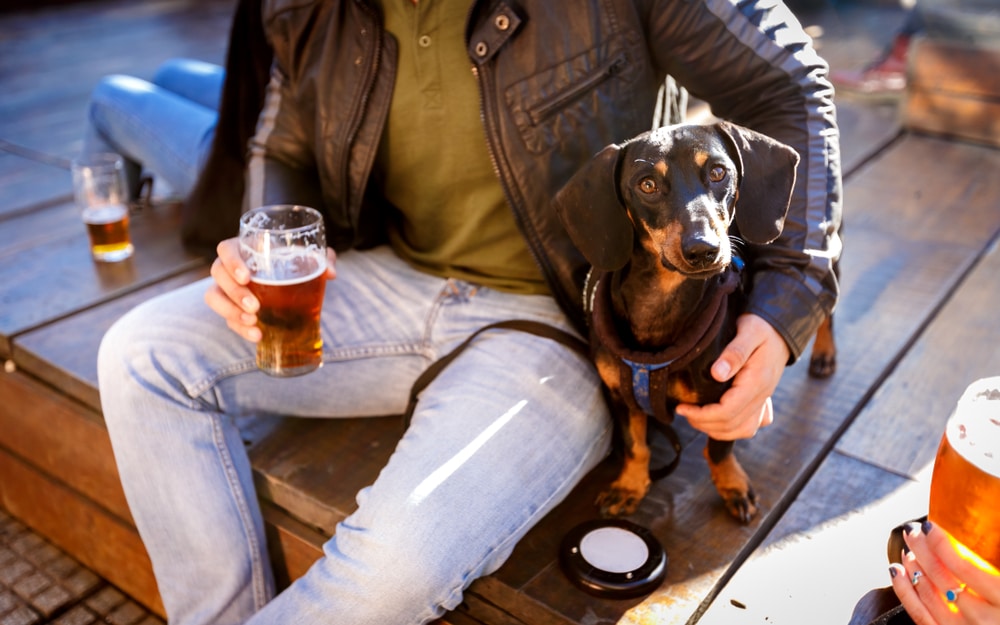A cocktail on a summer night, champagne to celebrate big achievements, a beer or two with new colleagues, or a glass of wine with your favorite TV show, alcohol is a big part of our human lives. But what about our furry friends, do dogs enjoy alcohol? Can they have it? And how fast does alcohol affect a dog anyway?
For most dogs, it takes 15 to 30 minutes to show the first effects of alcohol. It can also take 60 minutes to show the peak effects of alcohol ingestion. Alcohol poisoning in dogs is very serious, however, when ingested in a smaller dose and when given the proper treatment, dogs can recover eventually. As in humans, the effects of alcohol and how fast they will affect your dog depends on many things such as the type, concentration, and amount ingested, what breed and size your dog is, and other factors.
Do Dogs Like Alcohol?
Thankfully, most dogs dislike alcohol and would rather not taste it. However, because of their curiosity and love for their owner, they desire anything their human has, eats, and drinks.
Also, drinks with fruits and more of a sweet smell, such as cocktails, punches, ciders, and seltzers, may attract dogs more than plain alcoholic drinks.
How Can Dogs Come In Contact With Alcohol?

When we think of alcohol our first thought is alcoholic drinks. However, besides drinks, there are a lot of everyday things that contain alcohol in some form.
A List Of Alcohol-Containing Products
Here are some of the alcohol-containing products that dogs can come in contact with easily:
- Mouthwashes and dental sprays
- Hand sanitizer
- External flea sprays and grooming agents
- Fermenting bread dough
- Detergents
- Antifreeze
- Nail polish remover
- Perfumes and colognes
Out of all the forms of alcohol, ethanol, methanol, and isopropanol are the alcohols most frequently present in everyday products. Ethanol is present mainly in a variety of alcoholic drinks.
On the other hand, methanol is most commonly found in antifreeze, detergents, and others. Rubbing alcohol and flea sprays can contain isopropanol. So, since we can easily get in touch with isopropanol, it’s good to mention that it’s twice as toxic as ethanol.
Alcohol Concentrations In Drinks And Household Products
Your dog will not react the same as us if it licks spilled beer versus if it chugs some hand sanitizer. Well, in some ways it’ll react the same as us, right? Different substances will cause the same effect in different amounts depending on the type of substance ingested and its alcohol percentage.
The reported oral ethanol fatal dosage in dogs is 4.3 to 6.2 ml/kg.
To have some idea of how much this is, here are some examples of ethanol concentrations:
- Beer – has 2.5-3.5% ethanol
- Wine – 10-20%
- Whiskey – 40-45%
- Mouthwash – 14-27%
- Cologne/perfume – 50%
- Hand sanitizers – 60-90%
So, as we can tell, the lethal dose of a beer for your dog is 2 cups of 100ml, but a hand sanitizer can be lethal in a dose of 5ml, or a lick or two. However, in doses smaller than the lethal, alcohol can and will show negative effects on your dog’s health.
Alcohol Absorption
After a dog has ingested a substance with alcohol, it is rapidly absorbed in the gastrointestinal tract. Ethanol is primarily absorbed in the stomach, the small intestines, and the colon.
Furthermore, it is known that the skin absorbs alcohol quickly, particularly if it is damaged. This is important to know as many topical skin sprays and detergents contain alcohol.
It may be necessary to use alcohol on your dog’s skin to remove a tick, for example, but it’s still recommended to ask your vet about this beforehand. Additionally, there are other options than using alcohol to remove a tick such as certain tick-removing products.
How Long Does It Take To See The Effects Of Alcohol?
The type, concentration, and amount of alcohol consumed, as well as your dog’s breed and size, are all factors that can determine how quickly alcohol affects your dog, just like it does in humans.
The majority of canines require 15 to 30 minutes to show the first signs of alcohol ingestion, and up to 60 minutes to display the peak effects. It is interesting to know that it takes longer when there is food present in the stomach.
What Are The Effects Of Alcohol On Dogs?
Can you imagine your dog drunk? Well, alcohol can have the same effects on dogs as it does on people. Not only that, but these effects will be substantially worse for dogs.
Here we have some of them:
- Lack of coordination and drowsiness
- Weakness, tiredness, and confusion due to dangerously low blood sugar
- Depression or lethargy
- Drooling and vomiting
- Low blood pressure
- Low body temperature
Alcohol can cause dogs to develop the potentially fatal illness known as metabolic acidosis. Numerous negative consequences result from it including heart attacks.
What To Do If Your Dog Ingests Alcohol?
If you know your dog has had a sip or a few licks of your wine or mixed drink, make sure they stop immediately.
Alcohol toxicity requires prompt medical attention. So, it is always better to act fast and call your vet. Depending on how much alcohol was consumed, some vets may encourage you to bring your dog in straight away for a checkup, while others may advise waiting to see how your dog reacts before bringing it in.
If your dog has gotten in contact with alcohol toxin on their skin, with a flea spray, for example, they may advise giving it a bath. In addition, if you can’t reach your vet, they may have a list of emergency vets on their website you can contact instead. Also, you can always call animal poison control as well.
When you visit the vet or an animal hospital it is good to bring any product packaging you may have with you. Also, as you travel there, make sure to protect your dog from injuries and falls or other intoxication-related incidents.
Frequently Asked Questions About Dogs And Alcohol
Have some more information about dogs and alcohol? Take a look below!
How Much Beer Will Make A Dog Drunk?
Even though beer has a low alcohol concentration, usually 2.5-3.5% will do it. It doesn’t take much to harm little dogs either. For instance, consuming 30-35ml will be enough to make a small dog drunk.
How Much Alcohol Can A Dog Drink?
It is not advised for a dog to drink even the smallest amount of alcohol. If you suspect they have or that they’ve come in contact with alcohol in any way, contact your vet or animal poison control as soon as possible.
How Long Does Alcohol Poisoning Last In Dogs?
Alcohol poisoning should not be taken lightly and could be lethal. The outcome depends on the dose, type of alcohol ingested, type and size of the dog, and many more factors.
Given the proper and timely treatment, some dogs will recover in 12 to 24 hours. In more complicated cases, it could take a couple of days in medical care to deal with the complications.
Final Thoughts: How Fast Does Alcohol Affect A Dog?
As much as dogs are not fans of the taste of alcohol itself, they are curious creatures. Therefore, accidents can happen, and they can ingest alcoholic beverages, especially if they are sweet and “easy to get.” Also, not to be forgotten, alcohol is present in other substances like medications, cosmetics, yeast bread dough, and other products and substances.
So, what’s got you curious about dogs and alcohol? Let us know what’s going on and why in the comments below!
